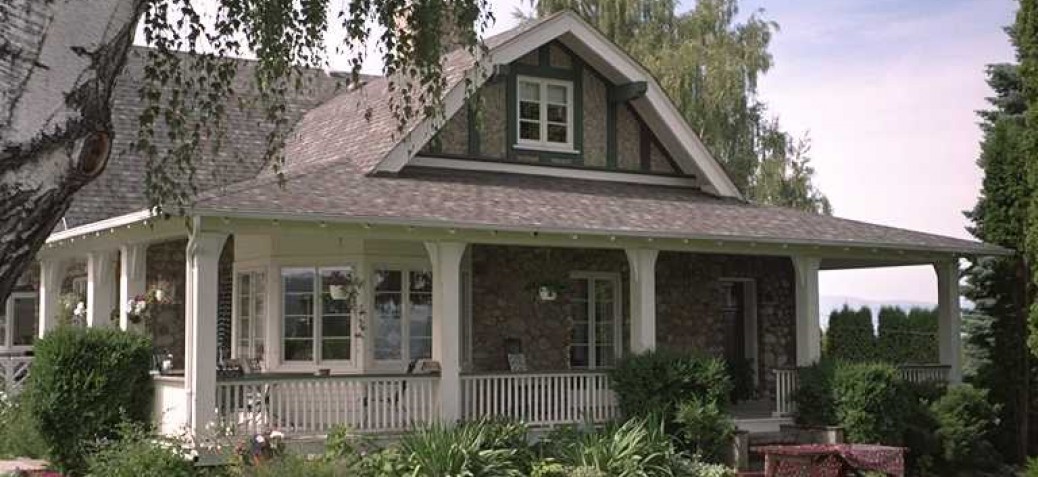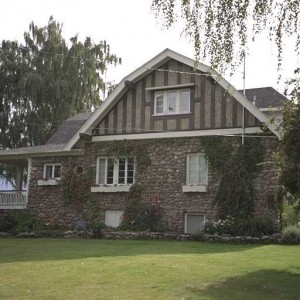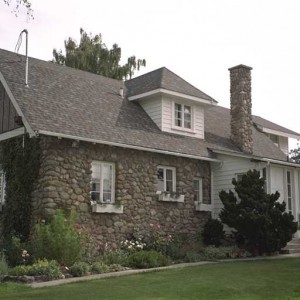Reid House
Place Description
The Reid House is a one and one-half storey Edwardian era rustic Arts and Crafts residence partially clad in cobblestone and distinguished by a gambrel roof. It is located in a rural context on spacious rolling grounds on the east side of Reid Road in the East Kelowna neighbourhood, far removed from the city centre. Set on a spacious landscaped lawn, there is an unimpeded vista from the house of the surrounding valley.
Heritage Value
The historical significance of the Reid House lies in its representation of the idyllic rural lifestyle of agricultural settlement promoted as part of the land settlements schemes of the pre-First World War era. Local settlers attempted to establish and promote an idealized agricultural community based upon the potential of prosperous fruit farms. The meticulous and orderly layout of this property, including the surrounding orchards and this gracious house, were frequently used in publicity material by local fruit and land development companies.
The civilized rural lifestyle is exemplified by the rustic Arts and Crafts architecture of this house, built in 1911 for Christopher Russell Reid (1889-1965) a prominent fruit farmer within the Kelowna community. The use of natural materials, including cobblestone walls, are appropriate to the country setting, while sophisticated details such as the generous wraparound porch with graceful support brackets and French doors evoke the genteel life of a gentleman farmer.
Additionally, this site is valued as an example of the residential work of Wesley A. Peters, a prominent early architect in Kelowna. His career was typical of the unstable nature of the architectural profession that mirrored the boom and bust cycles of the general economy. Peters arrived in Kelowna in 1909, and despite immediate success he left the area as a result of the 1913 depression and the outbreak of the First World War the following year. During his brief time in Kelowna, he designed a number of notable buildings amongst which the First United Church (1909), St. Andrew's Anglican Church (1910-1911), and St. Michael and All Angels Anglican Cathedral (1911-1913) survive.
Character Defining Elements
Key elements that define the heritage character of the Reid House include its:
- elevated location, set in a landscaped garden with a significant, unimpeded view overlooking the valley below;
- residential form, scale and massing as expressed by its one and one-half storey height and rectangular plan;
- elements of the Arts and Crafts style such as the use of natural materials;
- side gambrel roof with exposed rafter tails and gambrel dormer on the garden facade with exposed, projecting purlins
- wood-frame and masonry construction expressed by the cobblestone cladding and foundations and half-timbering with pebble-dash infill in the gabled ends and dormer;
- exterior elements such as its plain bargeboards with scroll-cut detail, full-width verandah on the garden facade with square columns and decorative brackets, square verandah balusters set at 45 degrees, and one central internal cobblestone chimney;
- asymmetrical fenestration, including the 4-light casement windows on the first storey, 3-light casement windows in front dormer, a polygonal bay window projecting into the verandah, 5-pane French doors, and round side elevation window;
- surviving interior features original to the date of construction; and
- landscape features such as the rolling lawns, mature specimen trees and various plantings around the property.






